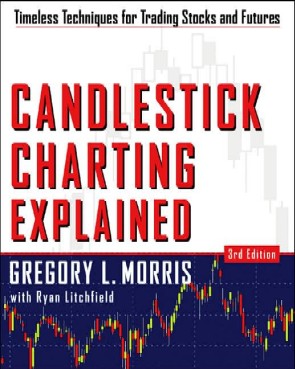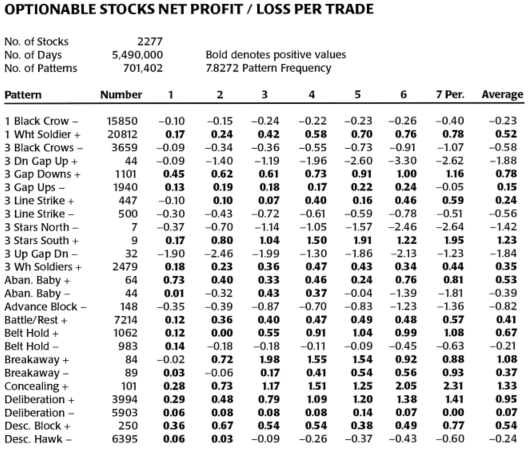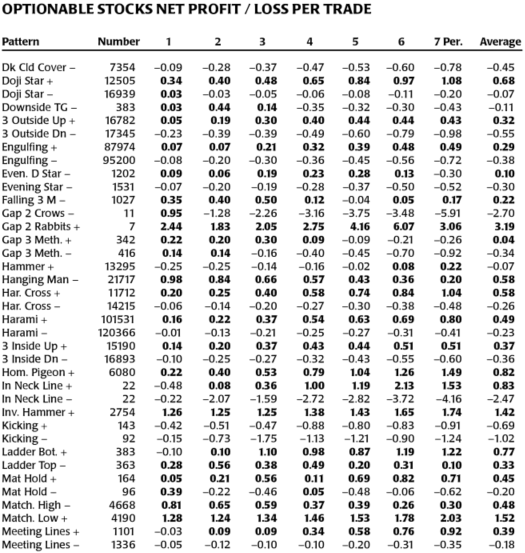 Additional information in regard to the determination of the suitability of candle patterns is to look at the Net Profit divided by the Net Loss per Trade. This would be a measure of the overall profitability of candle patterns based upon the prediction interval. Table A shows this data with the positive data emboldened.
Additional information in regard to the determination of the suitability of candle patterns is to look at the Net Profit divided by the Net Loss per Trade. This would be a measure of the overall profitability of candle patterns based upon the prediction interval. Table A shows this data with the positive data emboldened.
Trades that do not produce either a profit or loss are included in the Net Profit/Loss per Trade (Table A) calculation. The Net Profit/Loss per Trade value is simply the average percent gain (or loss) for all trades. Because the Net Profit/Loss per Trade value is the average result for all trades (winning, breakeven, and losing trades), it can be a positive or negative number, or even zero. If the Net Profit/Loss per Trade value is positive, it means the average trade produced a net profit. If the Net Profit/Loss per Trade value is negative, it means the average trade produced a net loss.
Note: The Net Profit/Loss per Trade value is the sum of all individual trade results divided by the number of all trades. If all trades produced either a gain or a loss (i.e., there are no 0.00 trade results), then the Net Profit/Loss per Trade value can also be calculated as follows:
Net Profit/Loss per Trade = (% Winners x Avg Win) + (% Losers x Avg Loss)
Note: The equation above uses a plus sign because Avg Loss is a negative amount. Also, if you do any of these calculations yourself, watch out for differences caused by rounding of the % Wins and % Losses (reciprocal of % Wins) values. For example, the table will display 71% for % Wins when 5 out of 7 trades are winning trades. A more precise value would be 71.4286%. The program used to create this table uses precise values in all of its calculations. The table displays the end results of its calculations as slightly rounded values for purposes of readability.
A good candlestick pattern will have positive Net Profit/Loss per Trade values across many timeframes. And, among those patterns producing a net profit per trade, the better patterns will be those with smaller Avg Loss (100 - % Wins) values (i.e., a -3.00% Avg Loss value is better than a -6.00% Avg Loss value). Candlestick patterns are not perfect, so when a trade doesn't work out, you want a pattern whose losing trades produce on average limited losses.


 Table A
Table A
From Table A one can quickly see the candle patterns that have a row full of positive (bold) returns by taking the net profit per trade and dividing it by the net loss per trade. This is good to know, but you must also look at the data in Table A in the previous article Candlestick Analysis – Statistics II in conjunction with this to ensure a single candle pattern did not yield excessive losses. The data in Table A in the aforementioned article shows only the percentage of winning trades (% Wins), but the reciprocal of that percentage (100 - %Wins = %Losses) would yield the percentage of losing trades.
Dance with the Trend,
Greg Morris





